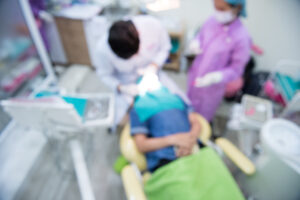
by Dr. Jacqueline S. Allen | Apr 19, 2017 | Blog, Endodontics, Endodontist, Root Canal
 Our natural teeth are complex, dynamic parts of a living organism – us! Endodontists play a crucial role in allowing us to keep our natural teeth, which in almost all cases provides the safest and most optimal health outcome.
Our natural teeth are complex, dynamic parts of a living organism – us! Endodontists play a crucial role in allowing us to keep our natural teeth, which in almost all cases provides the safest and most optimal health outcome.
According to the American Association of Endodontists, here are just some of the ways in which endodontists help your dental team preserve your natural teeth and keep them healthy for a lifetime.
How Endodontists Help Save Natural Teeth
- Endodontists partner with your general dentist. Endodontics is one of nine specialities recognized by the American Dental Association. Endodontists partner with general dentists and other specialists in diagnosis and treatment planning.
- Endodontists are experts in performing root canals. The root canal procedure, which is often the only way to preserve a natural tooth, typically makes up 95 percent of an endodontist’s workload. They use advanced technology and microsurgical techniques to improve patient comfort and save natural teeth.
- Endodontists receive additional training and are experts in tooth root structure. To become specialists, endodontists receive two years of extra training after completing dental school. They gain the expertise to treat everything from the most common to the most unusual or complex tooth root problems, which diminishes the need for retreatment.
- Endodontists provide a solid foundation for other restorative work. A properly done root canal is an excellent platform on which to build a crown or other restoration. This makes it less likely a patient will experience future complications and have to pay for additional work on the tooth.
“Tooth loss can lead to multiple problems over the long term, including shifting teeth, periodontal challenges and the cost and maintenance of prosthetics,” says Dr. Jacqueline S. Allen, who practices with the Phoenix Endodontic Group. “Our goal as endodontists is to preserve your natural teeth whenever possible and keep them healthy.”

by Dr. Jacqueline S. Allen | Mar 15, 2017 | Blog, Endodontics, Endodontist, Root Canal
 Last month, this blog covered the top myths surrounding the root canal process, and we emphasized the importance of being a savvy Internet consumer when it comes to evaluating medical information. One of the factors involved in myths about root canals spreading across the web happens when readers confuse a description of what root canals used to be like with what the process is generally like today. Here is a brief list of “truths” about what patients typically experience during today’s root canals to help you better understand what you would experience if you were to need a root canal.
Last month, this blog covered the top myths surrounding the root canal process, and we emphasized the importance of being a savvy Internet consumer when it comes to evaluating medical information. One of the factors involved in myths about root canals spreading across the web happens when readers confuse a description of what root canals used to be like with what the process is generally like today. Here is a brief list of “truths” about what patients typically experience during today’s root canals to help you better understand what you would experience if you were to need a root canal.
Today’s Truths About Root Canals
- Today’s root canals relieve pain, rather than cause discomfort. Many root canals are performed to relieve the pain of toothaches caused by pulp inflammation or infection. Modern endodontic techniques and anesthetics keep patients comfortable during the procedure, and after a brief healing period, many patients report their tooth feeling better than ever.
- Today’s root canals are often the best way to save your natural tooth. Often, by the time a root canal is called for, the tooth is either experiencing infection or inflammation of the pulp, or the tooth has been damaged by a fracture. Root canals and other endodontic treatments can often preserve the natural tooth, avoiding the loss of function and appearance change that comes with having the tooth extracted.
- Today’s root canals can last a lifetime! While much depends on how well you care for your teeth and gums after the root canal is performed, if your mouth remains healthy, it is likely your natural tooth that’s been treated with a root canal can stick around as long as you do. It’s important to ensure the crown that’s placed on top of the treated tooth remains structurally sound, because it is your first line of defense against infection or decay that could compromise the tooth.
“It’s very important to get up-to-date information on root canals, since today’s procedure is unlike what your relatives or friends may have experienced a generation – or even a decade – ago,” says Dr. Allen, who practices with the Phoenix Endodontic Group. “The truth is, getting a root canal today is very likely to offer permanent relief from pain in your natural tooth that’s caused by infection or dental injury.”

by Dr. Jacqueline S. Allen | Feb 15, 2017 | Blog, Endodontics, Root Canal
 These days, it’s becoming more and more important to be a skeptical reader when it comes to researching medical information online. While a lot of quality sites exist, some websites perpetuate misinformation, making it harder to “do your homework” before you speak with your general dentist or an endodontist about important dental procedures such as root canals.
These days, it’s becoming more and more important to be a skeptical reader when it comes to researching medical information online. While a lot of quality sites exist, some websites perpetuate misinformation, making it harder to “do your homework” before you speak with your general dentist or an endodontist about important dental procedures such as root canals.
Here are three common myths about root canals that are often found when doing an online search, as well as accurate information to counter each falsehood.
Busting the Top 3 Myths About Root Canals
Myth #1: Root canals are painful. It’s easy to see why this myth exists. Many patients who come in for a root canal are suffering from the pain of a damaged tooth, or have decay that is causing the pulp of the tooth to become infected. These conditions can be very uncomfortable and can endanger the natural tooth. However, root canal treatment typically relieves the pain caused by these conditions, and preserves the natural tooth, as well.
Myth #2: Root canals are only a temporary solution. While few dental treatments last a lifetime, if a root canal is done by a qualified endodontist, its benefits can last for many years, even decades. It’s important to have a restoration such as a crown placed over the root canal to protect it afterward and to continue a regular daily brushing and flossing routine to ensure the treated tooth remains strong.
Myth #3: Extractions are often a better choice than getting a root canal. Because of the difficulties in chewing and speaking that occur when one loses a natural tooth, and the danger of bone resorption if enough natural teeth are extracted, a root canal should at least be considered when a natural tooth is failing. Root canals have a success rate of 85 percent or more, and a tooth that’s had a root canal done can also receive a root canal retreatment or an apicoectomy if additional treatment is needed to stabilize and save the tooth.
“Root canals are a cost-effective, safe, comfortable way to preserve your natural teeth,” says Dr. Jacqueline S. Allen, who practices with the Phoenix Endodontic Group. “Learn the facts about the procedure and don’t hesitate to call a dental professional if you need a consultation.”

by Dr. Jacqueline S. Allen | Nov 14, 2016 | Blog, Root Canal
T here’s no reason to feel bad about being afraid of having a root canal treatment – but don’t let your fear stop you from doing something can be good for your health. More than half of Americans surveyed in 2014 said they were afraid of having a root canal performed, although more than three-quarters of those surveyed also said they wanted to preserve their natural teeth if at all possible – something that root canals have a very good track record of doing.
here’s no reason to feel bad about being afraid of having a root canal treatment – but don’t let your fear stop you from doing something can be good for your health. More than half of Americans surveyed in 2014 said they were afraid of having a root canal performed, although more than three-quarters of those surveyed also said they wanted to preserve their natural teeth if at all possible – something that root canals have a very good track record of doing.
Here are a few of the top fears that people express about having a root canal treatment, paired with facts and advice to lower your fear level.
Fears and facts about root canals
Fear #1: Root canals are extremely painful.
Fact: Root canals usually relieve pain rather than cause it. Your endodontist may prescribe antibiotics to reduce infection, and he or she will use a local anesthetic to ensure the area being worked on is completely numb. The procedure itself, since it cleans out the canal and replaces the pulp of the tooth with an artificial material, has almost no pain associated with it, and post-operative discomfort is usually mild and of short duration.
Fear #2: If I have a root canal done, it may fail and I’ll have to go through the entire process again.
Fact: Root canal treatments have success rates above 90 percent, and if an appropriate restoration (such as a crown) is placed on top of the affected tooth, it can save the natural tooth for years if not decades to come. If a root canal does fail, there are additional options, including root canal retreatments and apicoectomies, that are available for saving your natural tooth.
Fear #3: If I have a root canal, I may lose the tooth anyway and I’ll have wasted money on the treatment instead of just getting an extraction.
Fact: Nothing can replace your natural teeth, so it’s best if every effort is made to save them. If you were to opt for an extraction, you’d also need to budget for a dental implant, a bridge, or dentures, the cumulative cost of which could cost far more than a root canal.
“When you have a compromised tooth that needs attention, it’s best to have the facts and not let your fears dictate the sort of treatment you receive,” says Dr. Allen, who practices with the Phoenix Endodontic Group. “Root canals can be an affordable, comfortable and effective treatment for an injured or infected tooth.”

by Dr. Jacqueline S. Allen | Oct 24, 2016 | Blog, Dental Implants, Endodontics, Root Canal
 Dental implants have been offered in recent years as a panacea for fixing the problem of ailing teeth. However, the reality when it comes to treating a badly injured or infected tooth is more complex. Both endodontic procedures such as root canals and dental implants have their proper place – your dental care team can help determine what treatment will be most effective for you.
Dental implants have been offered in recent years as a panacea for fixing the problem of ailing teeth. However, the reality when it comes to treating a badly injured or infected tooth is more complex. Both endodontic procedures such as root canals and dental implants have their proper place – your dental care team can help determine what treatment will be most effective for you.
Here are four common myths related to dental implants, and the factual situation in each case.
Myths related to dental implants and root canal treatments
Myth #1: The best thing to do in all cases with an injured or infected tooth is to replace it with a dental implant.
There are a range of factors that will determine if a dental implant or a root canal is the best way to proceed. Although dental implants would appear at first glance to permanently resolve the issue with a troubled tooth, they can also cost more and require more visits to the dentist to complete. Most root canal treatments, which remove inflamed pulp and clean, fill and seal the inside of the tooth, can be accomplished in a single visit and are virtually painless.
Myth #2: Dental implants have a higher success rate than root canals.
A number of studies have shown both dental implants and root canals can have success rates of more than 95 percent. Currently, both procedures are considered excellent choices for treating an ailing tooth, and decisions to go with one procedure over the other should be based on factors related to an individual’s unique situation.
Myth #3: If you have a root canal and it fails, you need to have an extraction done and a dental implant placed.
Not necessarily. Root canals can fail for reasons that include damage to the crown protecting the treated tooth, additional tooth decay, or hidden canals that were not properly cleaned and filled the first time. However, endodontic retreatments of root canals can successfully restore the natural tooth to health in as many as 75% – 88% of all cases.
Myth #4: Your endodontist can’t help you if you need an implant.
Actually, the American Association of Endodontists has released a position statement affirming that if a endodontist determines a tooth must be extracted and a dental implant placed, he or she may proceed with the extraction and the placement of the implant if it is in the best interest of the patient.
“The decision whether to save a natural tooth or to proceed with an extraction and dental implant can be a difficult one,” says Dr. Jacqueline S. Allen, who practices with the Phoenix Endodontic Group. “Your endodontist can help you sort through your options and make the best decision for your individual health needs.”

by Dr. Jacqueline S. Allen | Oct 12, 2016 | Blog, Endodontics, Root Canal
 Endodontically treated teeth can last a lifetime. Some of these teeth, however, may not heal properly or may develop new problems months, or even years, after they were initially treated. An additional endodontic treatment, called a retreatment (a second root canal procedure), can be performed, which could again, allow a patient to keep his or her tooth for a lifetime.
Endodontically treated teeth can last a lifetime. Some of these teeth, however, may not heal properly or may develop new problems months, or even years, after they were initially treated. An additional endodontic treatment, called a retreatment (a second root canal procedure), can be performed, which could again, allow a patient to keep his or her tooth for a lifetime.
Root canal treatment is like any other medical or dental procedure. It may not heal or respond to treatment, as expected for many different reasons:
- Often times, the permanent or temporary restoration may not have prevented salivary contamination inside the tooth.
- There may have been an extended period of time between when the crown or other restoration was placed, and when the root canal treatment was completed. Most endodontists and studies agree that a definitive restoration should be placed within one month following an endodontic procedure.
- There may be canals that were undetected, or canals that were too narrow, or calcified, to negotiate for the original practitioner.
There are occasions when a new problem arises with a tooth that has been treated previously that may compromise the original endodontic procedure:
- If a tooth develops a vertical fracture after endodontic therapy, it is no longer a viable tooth to keep in the oral cavity.
- A new cavity could develop in the tooth and expose the root canal to recontamination with bacteria.
- The restoration that was placed in or on the tooth after the endodontic treatment was complete can break down, creating microleakage of bacteria into the canals, which can cause recontamination.
Before endodontic retreatment is started, the endodontist may want to take a CBCT of the tooth. A CBCT is a 3-dimensional X-ray that allows the endodontist to look at the tooth in all planes to help diagnose a pattern of bone loss that may be indicative of a vertical fracture, canal anatomy that may not have been addressed in the original endodontic therapy, and other factors that will help your endodontist determine the best treatment for the tooth.
Even though a CBCT may offer more information about why a retreatment may be necessary, sometimes the endodontist must go back into the tooth and look for a potential cause that prevented the original root canal from healing.
A retreatment procedure consists of removal of the original contents of the crown and canals and exploration of the tooth and internal root structure that remains. If any canals were missed, they are addressed at that time. If a fracture exists, then the tooth will ultimately need an extraction, and may be removed at that time or may be removed at some point in the future by another practitioner. Once these issues are addressed, and once the canals are free of their filling material, they are disinfected, and an antibacterial paste is placed in each of them. This paste may be left in the tooth for several weeks until the tooth is symptom-free, and all other clinical signs of infection have disappeared. At that point, the patient returns, and the root canals would once again be filled with the endodontic filling material and a restoration crown would top the tooth. Most endodontists will evaluate the tooth for proper healing for several years after a retreatment is performed.
Although the goal of primary endodontic therapy is to save the natural tooth for a lifetime, there may be factors that can affect that overall outcome. When this happens, other treatments can save a natural tooth for a lifetime.

 Our natural teeth are complex, dynamic parts of a living organism – us! Endodontists play a crucial role in allowing us to keep our natural teeth, which in almost all cases provides the safest and most optimal health outcome.
Our natural teeth are complex, dynamic parts of a living organism – us! Endodontists play a crucial role in allowing us to keep our natural teeth, which in almost all cases provides the safest and most optimal health outcome.

 Last month, this blog covered the top myths surrounding the root canal process, and we emphasized the importance of being a savvy Internet consumer when it comes to evaluating medical information. One of the factors involved in myths about root canals spreading across the web happens when readers confuse a description of what root canals used to be like with what the process is generally like today. Here is a brief list of “truths” about what patients typically experience during today’s root canals to help you better understand what you would experience if you were to need a root canal.
Last month, this blog covered the top myths surrounding the root canal process, and we emphasized the importance of being a savvy Internet consumer when it comes to evaluating medical information. One of the factors involved in myths about root canals spreading across the web happens when readers confuse a description of what root canals used to be like with what the process is generally like today. Here is a brief list of “truths” about what patients typically experience during today’s root canals to help you better understand what you would experience if you were to need a root canal.
 These days, it’s becoming more and more important to be a skeptical reader when it comes to researching medical information online. While a lot of quality sites exist, some websites perpetuate misinformation, making it harder to “do your homework” before you speak with your general dentist or an endodontist about important dental procedures such as root canals.
These days, it’s becoming more and more important to be a skeptical reader when it comes to researching medical information online. While a lot of quality sites exist, some websites perpetuate misinformation, making it harder to “do your homework” before you speak with your general dentist or an endodontist about important dental procedures such as root canals.
 here’s no reason to feel bad about being afraid of having a root canal treatment – but don’t let your fear stop you from doing something can be good for your health.
here’s no reason to feel bad about being afraid of having a root canal treatment – but don’t let your fear stop you from doing something can be good for your health. 
 Dental implants have been offered in recent years as a panacea for fixing the problem of ailing teeth. However, the reality when it comes to treating a badly injured or infected tooth is more complex. Both endodontic procedures such as root canals and dental implants have their proper place – your dental care team can help determine what treatment will be most effective for you.
Dental implants have been offered in recent years as a panacea for fixing the problem of ailing teeth. However, the reality when it comes to treating a badly injured or infected tooth is more complex. Both endodontic procedures such as root canals and dental implants have their proper place – your dental care team can help determine what treatment will be most effective for you.
 Endodontically treated teeth can last a lifetime. Some of these teeth, however, may not heal properly or may develop new problems months, or even years, after they were initially treated. An additional endodontic treatment, called a retreatment (a second root canal procedure), can be performed, which could again, allow a patient to keep his or her tooth for a lifetime.
Endodontically treated teeth can last a lifetime. Some of these teeth, however, may not heal properly or may develop new problems months, or even years, after they were initially treated. An additional endodontic treatment, called a retreatment (a second root canal procedure), can be performed, which could again, allow a patient to keep his or her tooth for a lifetime.